Hoya Polyneura, or the “Fishtail Hoya,” thrives with simple care. Its delicate, veined leaves resembling fish tails make it a captivating addition to any collection. This plant flourishes in bright, indirect light, high humidity, and well-draining soil. If you’re ready to grow this stunning Hoya, let’s dive into the essentials for keeping it happy and healthy!
Understanding the Natural Habitat of Hoya Polyneura
In its native Himalayan environment, Hoya Polyneura grows as an epiphyte, clinging to trees and thriving in humid conditions with filtered sunlight. This plant enjoys cooler temperatures than many other tropical Hoya species, making it well-suited to indoor environments when provided with the right care.
Hoya Polyneura Care
1. Light Requirements
Like other Hoya plants, Hoya Polyneura prefers bright, indirect light. However, it is more sensitive to direct sunlight, which can scorch its delicate leaves.
- Best light conditions: A bright spot with indirect sunlight, such as near a north or east-facing window, is ideal. If you notice the leaves losing their rich green color, it may be a sign that the plant needs more light.
- Too much light: Direct sunlight can cause leaf burn, turning the leaves yellow or brown. If your plant is exposed to harsh afternoon sun, move it to a shadier spot or use a sheer curtain to diffuse the light.
Tip: If natural light is limited, consider using a grow light to ensure your Hoya Polyneura gets the brightness it needs without the risk of scorching.
2. Watering Needs
Watering Hoya Polyneura can be tricky, as this plant prefers consistent moisture but is also prone to root rot if overwatered. The important aspect of this is to allow the top inch of soil to dry out before rewatering.
- How often to water: In the warmer months, water once the top inch of soil feels dry to the touch, which may be about once a week. In winter, reduce watering frequency to every two weeks, as the plant’s growth slows.
- Signs of overwatering: Yellowing leaves, soft stems, and a soggy pot are signs of overwatering. If this happens, allow the soil to dry out completely before watering again.
- Signs of underwatering: Drooping leaves or wrinkling of the leaves indicate that the plant is too dry.
Tip: Use a moisture meter to avoid overwatering or underwatering your Hoya Polyneura.
3. Ideal Soil Mix
Hoya Polyneura prefers a well-draining soil mix to ensure that its roots don’t sit in water. A good mix for this plant includes orchid bark, perlite, and peat moss or coco coir, which mimics the plant’s natural epiphytic growing conditions.
- Best soil mix: A combination of orchid bark, perlite, and peat moss provides excellent aeration and drainage. You can also add a small amount of succulent or cactus potting mix for extra drainage.
- Soil pH: This plant thrives in slightly acidic to neutral soil with a pH range of 6.0 to 7.0.
Tip: Make sure the container has drainage holes to avoid the accumulation of water at the base.
4. Temperature and Humidity
Hoya Polyneura is more sensitive to heat than other Hoya species. It prefers cooler temperatures, making it a great indoor plant for temperate climates.
- Temperature range: This plant thrives in temperatures between 60°F and 75°F (15°C-24°C). Avoid exposing it to temperatures below 50°F (10°C), as it may suffer from cold damage.
- Humidity: Hoya Polyneura loves higher humidity levels, ideally around 60% or more. If your home is particularly dry, especially in the winter, consider using a humidifier or placing the plant near a humidity tray.
Tip: Misting the plant occasionally or placing it in a bathroom with indirect light can help maintain humidity.
5. Fertilization
Fertilize Hoya Polyneura during its growing season (spring and summer) to encourage healthy growth and blooming. Be cautious, though, as excessive fertilization may result in accumulation of salts in the soil.
- When to fertilize: Use a balanced, water-soluble fertilizer once a month during its active growing season. In fall and winter, reduce or stop fertilizing as the plant enters dormancy.
- Fertilizer type: A balanced fertilizer with an NPK ratio of 10-10-10 or 20-20-20 is ideal for this plant.
Tip: Dilute the fertilizer to half the recommended strength to avoid damaging the roots.

Pruning and Propagation
Pruning
Pruning Hoya Polyneura is not strictly necessary, but you can trim leggy or overgrown vines to maintain the plant’s shape. Use sterilized scissors or pruning shears to make clean cuts just above a leaf node.
Propagation
Propagating Hoya Polyneura is relatively simple and can be done through stem cuttings.
- Stem cuttings: Take a 4-6 inch cutting with at least two nodes. You can propagate the cutting in either water or soil.
- Rooting in water: Place the cutting in a jar of water, making sure the nodes are submerged. Once roots develop (in a few weeks), you can transfer the cutting to a pot with well-draining soil.
- Rooting in soil: Plant the cutting directly into a small pot with a well-draining soil mix. Keep the soil moist and place the pot in a warm, humid environment with indirect light.
Tip: Using a rooting hormone can speed up the propagation process.
Common Pests and Problems
1. Mealybugs and Aphids
Like many indoor plants, Hoya Polyneura can occasionally attract pests such as mealybugs and aphids. These pests can be controlled with regular inspections and quick action.
- Mealybugs: These appear as small white cotton-like masses on the leaves and stems. Wipe them off with a cotton swab dipped in rubbing alcohol or treat the plant with a natural insecticidal soap.
- Aphids: Aphids are tiny insects that can stunt the growth of the plant. Spray the plant with neem oil or a mixture of water and dish soap to get rid of them.
2. Root Rot
Root rot is a common issue if Hoya Polyneura is overwatered or placed in poorly draining soil. To prevent this, always let the top layer of soil dry out between waterings and use a pot with drainage holes.
3. Yellowing Leaves
The appearance of yellow leaves can be a sign of excess watering, insufficient watering or lack of nutrients. Check your watering schedule and adjust as necessary. If the yellowing persists, consider fertilizing the plant or checking for pests.
Encouraging Hoya Polyneura to Flower
Hoya Polyneura produces beautiful clusters of star-shaped flowers, but getting it to bloom can be a challenge. Here are a few tips to encourage flowering:
- Mature plants bloom: Hoya Polyneura typically starts flowering once it reaches maturity, which can take a few years. Be patient and provide consistent care.
- Bright, indirect light: Ensure the plant receives plenty of bright, indirect light. Inadequate light levels may prevent the flowering of the plant.
- Cooler temperatures at night: Some Hoya species, including Hoya Polyneura, respond to slightly cooler nighttime temperatures (around 60°F or 15°C), which can trigger blooming.
Tip: Once your Hoya Polyneura starts blooming, avoid cutting off the flower peduncles, as the plant may produce more flowers from the same spot.
Conclusion
Hoya Polyneura is a stunning addition to any indoor plant collection, offering unique fishtail-shaped leaves and the potential for beautiful blooms. By following the care tips outlined in this guide, you can keep your Hoya Polyneura healthy and thriving for years to come. Whether you’re a seasoned plant enthusiast or a beginner, this plant’s striking appearance and relatively low maintenance make it a rewarding choice.
FAQs About Hoya Polyneura
Hoya Polyneura is a slow grower, but with proper care, you can expect steady growth throughout the year, especially during spring and summer.
While it can survive in low light, growth will be slow, and it may not flower. For optimal growth, place it in bright, indirect light.
Yellow leaves are often a sign of overwatering, but they can also indicate underwatering or nutrient deficiencies. Adjust your watering routine and check for pests or poor drainage.
Hoya Polyneura is considered non-toxic to pets, making it a safe option for households with cats and dogs.
You can propagate Hoya Polyneura through stem cuttings. Place the cuttings in water or soil and keep them in a warm, humid environment until roots develop.

